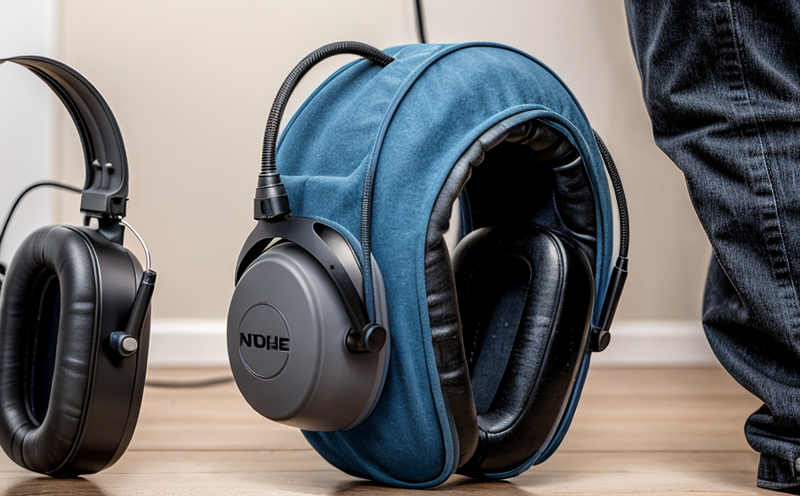EN 352-3 Helmet-Mounted Ear Muffs Attenuation Testing
The European Standard EN 352-3 specifies the requirements and test methods for helmet-mounted ear muffs designed to protect against noise. This standard is particularly important in industries where workers are exposed to high levels of sound pressure, such as construction, manufacturing, and mining.
The primary focus of this testing is to ensure that the helmets with integrated ear muffs provide adequate attenuation of sound. Attenuation refers to the reduction in intensity of a sound wave after it passes through an object or medium. In the context of occupational safety, ensuring proper attenuation means verifying that workers are shielded from harmful noise levels.
The test method outlined in EN 352-3 involves subjecting the ear muffs to standardized noise sources and measuring the reduction in decibel (dB) level at specific frequencies. This testing is crucial for compliance with occupational safety regulations, such as those set forth by ISO 1999:2018 and ANSI S3.19-2005.
The standard specifies three test conditions to evaluate the performance of helmet-mounted ear muffs:
- Free-field testing
- Covering factor measurement
- Wearer attenuation assessment
These tests are designed to simulate real-world scenarios where workers might be exposed to noise. Free-field testing ensures that the ear muffs provide consistent attenuation in an open environment, while covering factor and wearer attenuation tests account for how well the device fits and performs when worn.
The testing process begins with preparing the test specimens (the helmet-mounted ear muffs). The samples are selected based on their design specifications and intended use. Once prepared, they are subjected to a series of noise sources that simulate various environmental conditions. A sound calibrator is used to generate precise sound levels at different frequencies.
The results of these tests are meticulously recorded and analyzed. Compliance with the standard ensures that the products meet the required attenuation levels across all specified frequency ranges. This data is crucial for quality managers and compliance officers, as it directly impacts worker safety and health.
Understanding the importance of this testing, let's delve into why it matters in occupational safety.
Why It Matters
The attenuation testing of helmet-mounted ear muffs is critical for several reasons. First, it ensures that workers are adequately protected from noise-induced hearing loss, a prevalent issue in many industrial sectors. According to the World Health Organization (WHO), more than 160 million people globally suffer from occupational noise-induced hearing loss.
Secondly, compliance with EN 352-3 helps organizations meet regulatory requirements and avoid potential legal issues. Many countries have strict regulations regarding workplace safety and health, and non-compliance can lead to fines and penalties. By adhering to this standard, companies demonstrate their commitment to worker well-being.
Thirdly, the test results provide valuable data for R&D engineers in refining product designs. Continuous improvement is essential to enhance the performance of protective equipment. Engineers use the outcomes from these tests to identify areas where improvements can be made, such as enhancing noise reduction or improving comfort and fit.
The testing process also aids procurement teams by providing objective criteria for selecting appropriate products. By referencing the results from certified laboratories like ours, buyers can make informed decisions that prioritize both safety and cost-effectiveness.
In conclusion, the importance of this testing cannot be overstated. It plays a pivotal role in safeguarding workers' hearing and ensuring compliance with international standards. Let's explore how this service benefits our clients.
Benefits
The benefits of EN 352-3 helmet-mounted ear muffs attenuation testing are multifaceted, encompassing safety, regulatory adherence, and product reliability.
- Safety: Ensures that workers are protected from harmful noise levels, reducing the risk of hearing damage.
- Regulatory Compliance: Helps organizations meet international standards like EN 352-3, ISO 1999:2018, and ANSI S3.19-2005, thereby avoiding legal issues.
- R&D Enhancement: Provides data for continuous product improvement, leading to better designs and performance.
- Purchasing Guidance: Offers objective criteria for procurement teams when selecting protective equipment.
In addition to these benefits, the testing also enhances brand reputation by demonstrating a commitment to worker safety. This can be particularly advantageous in attracting and retaining high-quality employees who prioritize occupational health and safety.
The detailed results of this testing are invaluable for quality managers and compliance officers. They provide clear evidence that protective equipment meets or exceeds required standards, thereby fostering trust within the organization and among regulatory bodies.
Industry Applications
| Industry | Occupation | Standard Applied | Description |
|---|---|---|---|
| Construction | Civil Engineers, Construction Workers | EN 352-3, ISO 1999:2018 | Helmets with integrated ear muffs are essential for protecting workers from construction noise. |
| Mining | Miners, Tunnel Workers | EN 352-3, ANSI S3.19-2005 | The high-decibel environment in mines necessitates robust hearing protection. |
| Manufacturing | Machine Operators, Production Line Workers | EN 352-3, ISO 1999:2018 | Manufacturing plants often have significant noise levels that require effective hearing protection. |
| Aviation | Air Traffic Controllers, Pilots | EN 352-3, ICAO Doc 9467 | Helmets with integrated ear muffs are crucial for air traffic controllers to hear communications clearly. |
| Military | Soldiers, Crew Members | EN 352-3, MIL-STD-185A | The military uses these helmets in environments where noise levels can be extremely high. |
| Emergency Services | Firefighters, Police Officers | EN 352-3, ANSI S17.1-2016 | Helmets with integrated ear muffs are vital for emergency responders in noisy environments. |
The table above highlights the diverse applications of helmet-mounted ear muffs across various industries and occupations. Each industry has unique noise exposure requirements, making the testing process critical to ensuring worker safety and compliance.





